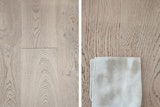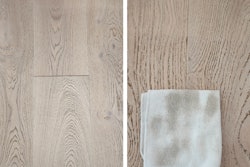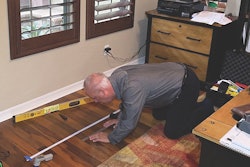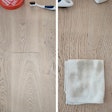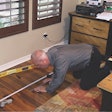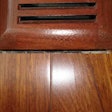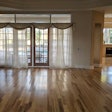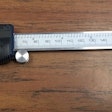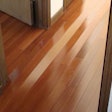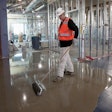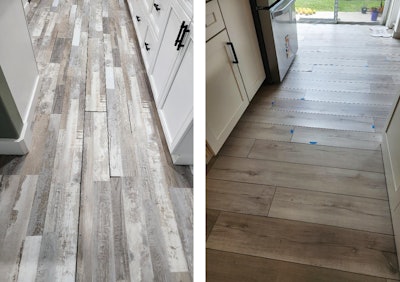
I have been in the flooring business my entire adult life. Early on, as a union apprentice, the training included all types of floor coverings, some with names we no longer use or seldom encounter, such as battleship linoleum, vinyl asbestos tile, asphalt tile, Axminster, Wilton wool carpet, and more. To be honest, I have always been a geek when it comes to how things are made and with what. This led to a long career as a journeyman installer who, in the 1980s, decided to focus on wood flooring but continued to keep up with the changes in all types of floor coverings. At some point, folks in my orbit began calling me for technical advice and to look at flooring issues. I turned my contracting company over to my son in the mid-’90s and went into sales/training and inspections. To make a long story palatable, now that I’m in my late 70s, all I do are inspections and consulting. I was getting a lot of calls for flooring issues other than wood, so I signed up for courses and certifications for resilient flooring and ceramic tile, and this, of course, led to a lot of studies related to these products. Many of you won’t be surprised that calls, texts and emails about vinyl flooring issues began coming in like a tsunami. This “revolutionary” product is advertised in large print as waterproof, extremely durable, stable and so easy to install that any handyperson can do it. Let’s delve into the fine print and how some of these products work in the real world.
Durability: When it comes to luxury vinyl, this depends on many factors, including the amount of wear layer and the thickness of the product (i.e., 5 mm, 13 mm, etc.), how flat the floor is and the type of traffic it has. If the subfloor is not flat to spec, a lot of bad things happen, including heavier wear on the high spots. In reality, in far too many instances, the wear layer that covers the photograph of wood or tile is about as thick as one’s fingernail.
Waterproof: Not so much. Read the installation instructions and you will find they mean waterproof from the top down, not the bottom up. This is a false flag, as gaps in the built-in vapor barrier exist. Consider also that some of their “barriers” are rubber, some are plastic, and many are cork. Cork is the bark of an oak that grows in Portugal and is far from waterproof. One can perform simple tests to prove that even the best-constructed products are not waterproof. Take two like pieces of LVP, click them tightly together, and lay them down on paper such as paper towels or newspaper. Pour water on the seam and let it sit until the water is gone. Look under the planks, and you will see that some water has seeped through the profile to the paper at the gap between the “barrier.” So, why wouldn’t moisture make its way via the same route from a concrete slab? Another easy test: Get four or five sample planks and lay them on a flat surface after ensuring they started with no cupping or other issues. Wait a week (or less), and you will find the planks have cupped. Why? Could the ambient relative humidity in a typical (non-desert) home affect these waterproof products? I have looked at too many cupping issues where there is absolutely nothing wrong with the installation, the in-use environment, or any other moisture problem to cause this cupping. Let me know if you find another reason. Many manufacturers have recently changed their specifications to include a physical vapor barrier, such as 6-mil plastic sheeting, and testing any on-grade concrete subfloors for moisture. I wonder why?
Humidity: Humidity can take a toll on vinyl plank flooring, so it should be monitored just like a wood floor; the humidity should range between 35–55% (or whatever the flooring manufacturer suggests).
Subfloor flatness: Subfloor flatness is important for any hard surface flooring, especially floating floors. The LVP specification is the same as for wood, with a few exceptions where the tolerance is tighter (1/8 inch in a 10-foot radius). Any deflection or trampolining will put stress on the locking system. Consider how small and fragile the locking systems are with many LVP floors and you will see why so many inspections are for “the floor is breaking and coming apart at the seams.”
Composition: What the heck is this stuff made from? How safe is it to manufacture, install and live with? The following are facts anyone can look up. “Luxury vinyl” is made of calcium carbonate, a chemical compound with the formula CaCO3 formed by three main elements: carbon, oxygen, and calcium. It is a common substance found in rocks in all parts of the world (most notably as limestone) and is the main component of shells of marine organisms, snails, coal balls, pearls, and eggshells. This all seems rather benign until you add the chemicals and compounds that are required to manufacture luxury vinyl. Traditional luxury vinyl plank flooring, both LVT and LVP, is made with a synthetic material that is formed by mixing and melting polyvinyl chloride resins (PVC), white pigments, calcium carbonate, plasticizers, fungicide, and UV stabilizers. These compounds are combined using heat and pressure. PVC contains dangerous chemical additives, including phthalates, lead, cadmium, and/or organotins, which can be toxic to your child’s health. These toxic additives can leach out or evaporate into the air over time, posing unnecessary dangers to children.
Are plasticizers harmful to humans? How toxic are organotins? Here’s some readily available information from Google: The toxicity of organotins in humans is most frequently reported as a loss of memory, insomnia, and other symptoms, including death. Commonly used plasticizers bisphenols and phthalates are among the most pervasive environmental toxins in our environment. Numerous studies have revealed that exposure to these synthetic chemicals can lead to reproductive and developmental disorders, including infertility and early puberty. If these facts are not enough to make you think before selling or even installing LVP, well, bon chance, buena suerte, buena fortuna, and viel gluck. Think, if you will, about the people who are physically making luxury vinyl and their health risks.
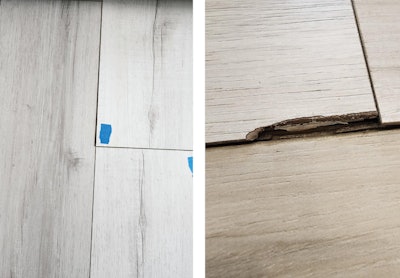 More common LVP problems I see: buckling and end peaking (at left) and chunks missing at board edges (at right).
More common LVP problems I see: buckling and end peaking (at left) and chunks missing at board edges (at right).










